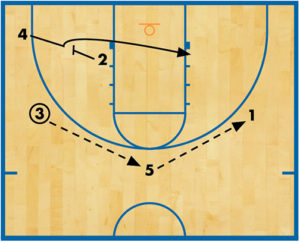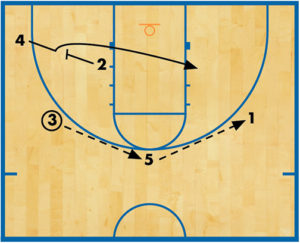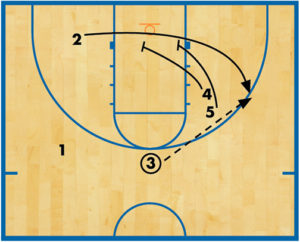Get running with the secondary break
When your team is a fast-breaking team, it’s critical for your players to run the break automatically without being told to “run!” Even when the primary break fails, your team needs to be prepared immediately to move into its secondary break.
We’ve found a great deal of success by running Roy Williams’ secondary break with back-screen options.
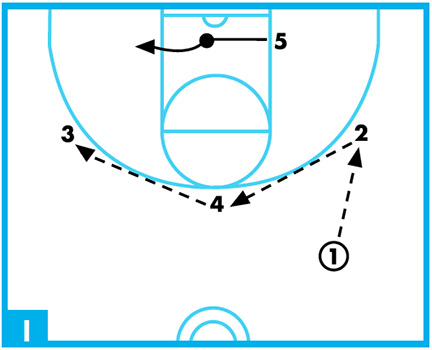 DIAGRAM 1: Secondary break (A). 1 passes to 2. 2 passes to 4. 4 passes to 3. 5 moves across the lane to the strong-side post.
DIAGRAM 1: Secondary break (A). 1 passes to 2. 2 passes to 4. 4 passes to 3. 5 moves across the lane to the strong-side post.
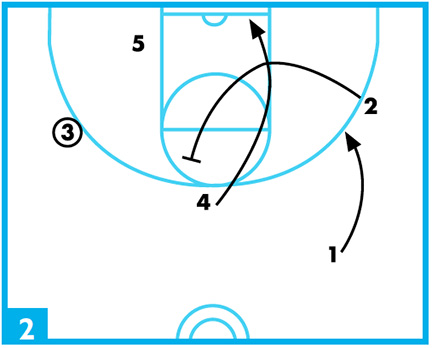 DIAGRAM 2: Secondary break (B). 2 sets a high screen for 4. 4 uses the screen to move into lane. 1 takes 2’s place on the weak-side wing. 3 tries to pass to 4, if there is an opening. If 5 has good position in the post, the pass can go to 5 which moves us into our “relocations” offense (Diagrams 4 and 5).
DIAGRAM 2: Secondary break (B). 2 sets a high screen for 4. 4 uses the screen to move into lane. 1 takes 2’s place on the weak-side wing. 3 tries to pass to 4, if there is an opening. If 5 has good position in the post, the pass can go to 5 which moves us into our “relocations” offense (Diagrams 4 and 5).
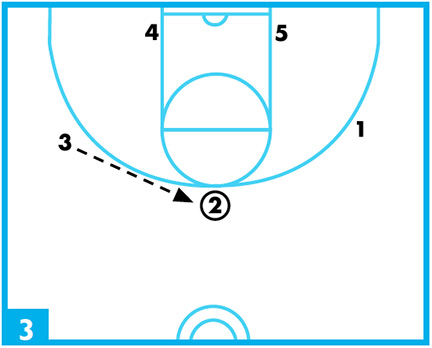 DIAGRAM 3: Secondary break (C). If all options are exhausted, 3 passes to 2 to reset the offense.
DIAGRAM 3: Secondary break (C). If all options are exhausted, 3 passes to 2 to reset the offense.
When the post is open, 3 has the option to pass to 5 from the secondary break. This leads to our “relocations” offense, as illustrated below in Diagrams 4 and 5.
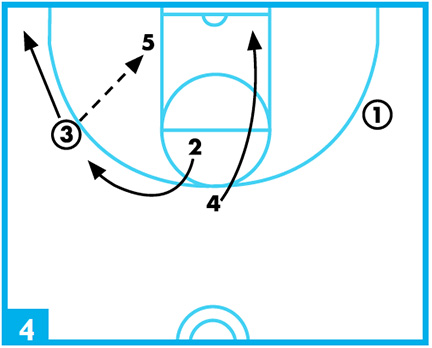 DIAGRAM 4: Relocations (A). 3 passes to 5 in the post. 3 relocates to the near corner, while 2 takes his place on the near wing.
DIAGRAM 4: Relocations (A). 3 passes to 5 in the post. 3 relocates to the near corner, while 2 takes his place on the near wing.
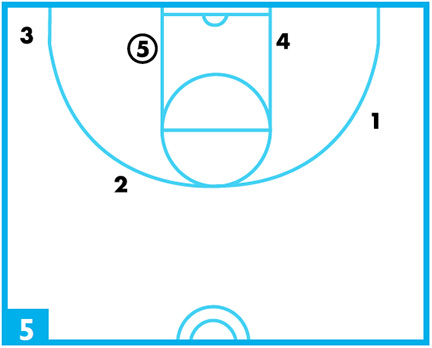 DIAGRAM 5: Relocations (B). Relocation positions always include near corner (3), near wing (2), opposite wing (1) and post dive (4).
DIAGRAM 5: Relocations (B). Relocation positions always include near corner (3), near wing (2), opposite wing (1) and post dive (4).
Secondary scrimmage drills
To become a better secondary-break, team try these three games in practice.
In all instances, a team only scores on a primary break, secondary break, relocations or offensive rebounds. When the break stalls, blow the whistle and award the other team the ball.
→ Secondary Scrimmage (three teams). Divide your squad into first-teamers (black), second-teamers (white) and third-teamers (red). Teams rotate on and off the court at your pace.
Black gets points for baskets or fouls on shots (one if missed shot three if made). White gets points for baskets fouls on shots and offensive rebounds. Red gets double points for baskets offensive rebounds and fouls on shots.
→ Secondary Scrimmage (two teams). Divide your squad into first-teamers (black) and second-teamers (white). Have a set time to scrimmage before they can sub (90 seconds to start and built up to three minutes). Hit the whistle, allow some time to breathe and get back at it.
Black gets points for baskets, and white gets points for baskets and offensive rebounds. This keeps both teams aggressive, and it puts the starters at a disadvantage to overcome.
→ Controlled Secondary Scrimmage (three teams). Divide your squad into first-teamers (black), second-teamers (white) and third-teamers (red). White stays on defense at one end, with red at the other.
Black runs the fast break for 10 possessions both ways. Keep scoring to keep it competitive. Whichever team is waiting to play defense should be running sideline-to-sideline until the first person on the fast break crosses midcourt coming at them.

